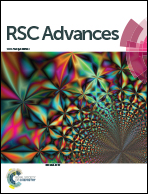Spectroscopic studies on the interaction of terpyridine-CuCl2 with cysteine†
Abstract
Interaction of the classical coordination complex TpyCuCl2 (Tpy = terpyridine) with cysteine was studied. Addition of cysteine to the solution of TpyCuCl2 was found to give greatly enhanced fluorescence. UV-vis absorption and mass spectroscopic analyses were conducted to investigate this reaction under various conditions. These studies indicate that in a pure water solution (pH = 6.10–6.55), cysteine can reduce Cu(II) to generate TpyCuSCH2CH(NH2)CO2H with greatly enhanced fluorescence. In a HEPES buffer solution (pH = 7.40), the Tpy ligand can be further displaced off the copper center, contributing to the enhanced fluorescence.


 Please wait while we load your content...
Please wait while we load your content...